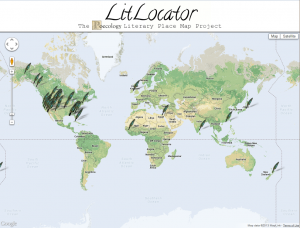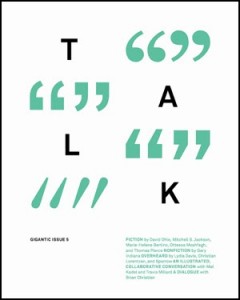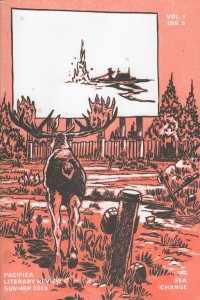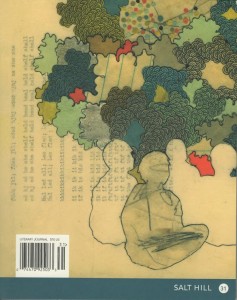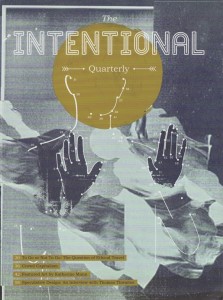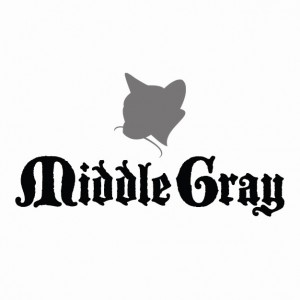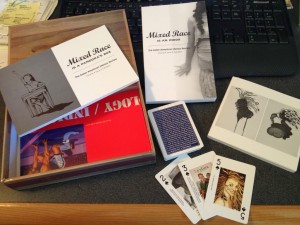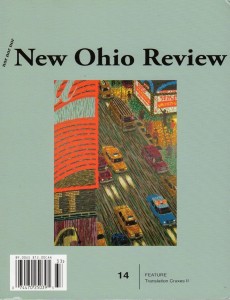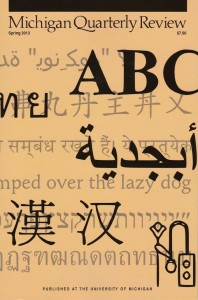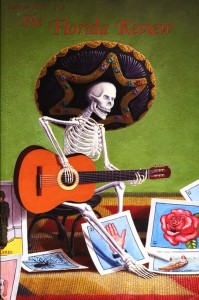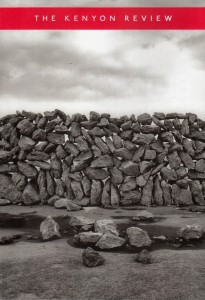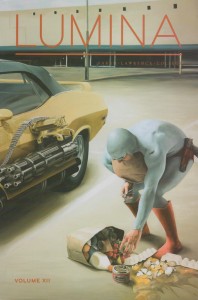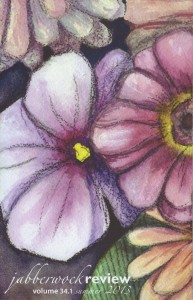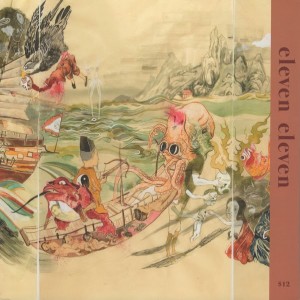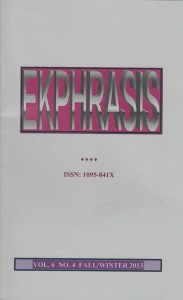Poecology magazine releases a new feature: the Literary Locator. This virtual map has a pin for each piece published in Poecology where the author lives. You can see literature written from around the world; simply click on the pin to start reading. They are currently partnering with other online literary magazines (such as Terrain.org) to get more literature on the map. In 2014, the map will be open to submissions and nominations of poetry, fiction, and nonfiction that are published online.
NewPages Blog
At the NewPages Blog readers and writers can catch up with their favorite literary and alternative magazines, independent and university presses, creative writing programs, and writing and literary events. Find new books, new issue announcements, contest winners, and so much more!
New Literary Locator
Spread the word!
Gigantic Phone
With the latest issue of Gigantic, we got a letter telling us about the special Gigantic Phone feature, “both a throwback—part answering machine, part hotline—and a move toward the future.” Call (917) 719-2166 to hear audio pieces from the writers and artists of the magazine, including Marie-Helene Bertino, Joe Wenderoth, Thomas Pierce, Mitchell S. Jackson, Martin Roth, Andrea, McGinty, and Ashley Farmer. I have to say; I tried it out, and it’s pretty cool.
Spread the word!
Call for Papers: J-SAPS’ Special Issue on Teachers and Teacher Education
From the Journal of Social and Policy Sciences: Teachers are central to education systems across the world. While good teaching has been a focus of scholarly reflection for a long time, the universalization of education has also turned it into a public policy issue. Introduction of free universal primary education (UPE), as set out in the first Education for All (EFA) framework in 1990, has increased the demand for trained teachers in response to huge and rapid increases in the student enrollment. The gaps between teacher demand and supply have resulted in severe shortages of qualified teachers in developing countries. Teacher shortages plague many education systems often undermine the effectiveness of interventions aiming to improve student access to quality education. These problems call for a scholarly effort to develop insights about teaching and teacher education in different contexts.
To critically understand the role of teachers in the modern educational systems, many questions are worthy of exploration by the researchers and educationists. Who are the individuals who predominantly make up the teaching cadre? Who are the individuals engaged in preparing teachers, namely the teacher educators, and what qualifies them to do such work? What influences the practices of teachers? What shapes the practices of teacher educators? How do organisational contexts matter in the ways teachers learn and develop? That is to say, are there any differences in the ways teachers develop over time in public and private schools and/or at different levels of schooling? How do organisational contexts matter in the ways teachers educators learn and develop?
Looking specifically at teacher education, what practices characterize the work of teacher educators in Pakistan? How do teacher educators learn to do their work? What forms of knowledge do teacher educators’ use that differ from those used by teachers in general, and how do these forms of knowledge develop? And what might high-quality preparation of teacher educators entail?
How might accountability policies influence the work of teachers and teacher educators? What are relationships between research and practice related to the development of teacher educators? What Policy Interventions may contribute positively to the improvement in Teachers Education/Performance?
For the upcoming issue of Journal of Social and Policy Sciences, we invite research and/or conceptual articles and case studies that will address some of the questions mentioned above, particularly in Pakistan/South Asia.
Submission of Full Papers: November 15, 2013
Spread the word!
Feature on Sean Thomas Dougherty
In a special feature in the newest issue of The Bitter Oleander, Sean Thomas Dougherty is both interviewed and shares some of his poetry. Even in his interview, he responds to questions with clear, crisp, and inviting writing. Here’s an excerpt from a question about his childhood: “As a teenager I lived in Manchester, NH. My father sold things. He sold candy. He sold chemicals for restaurants. He drove every day with samples. My mother had gone to law school and was blacklisted for her politics. She worked at a radio station. She moved up. She became a DJ.
“Driving I could hear my mother’s voice curling through the white mountains and the red brick mills.
I spent the days at my friend Garry’s house. He was Haitian and I’d sit over there listening to them speak Patois, his mother always pushing a plate of plaintain and rice in front of me, eat eat eat she’d say, you must get strong. His father never said much. Once he took me by the hand and led me downstairs and showed me the rabbits, he lifted one and in a flash slit its throat. Blood on the damp concrete. The basement floor sticky with blood.
“Like the lost relatives the Tonton Macout took. The sepia’d photos of faces in the big album we would flip through to see the children playing on the high cliff.
“Once years later me and his brother robbed a pharmacy.”
Spread the word!
Fractured Ecologies: Call for contributions
Fractured Ecologies: Call for contributions to an edited collection on environmental criticism and radical experimental writing
Since the 1990s, ecocriticism has influenced the ways we study literature, but fractures remain. If environmental scholars are to continue to challenge conventional approaches to literary study, inventive methods must be continually developed and improved. British scholar Harriet Tarlo has made a call for environmental engagement with experimental writing, and reminds us that “very few eco-critics engage with innovative or experimental writing.” Franca Bellarsi agrees, and emphasizes the real need to research “green ethics in different avant-garde practices.”
And while there has been some preliminary ecocritical work on what can be called experimental nature-writing, so far the most radical writing forms have largely been overlooked. Wild avant-garde writing is a limit case of sorts, and the difficulties in studying such forms are impossible to really avoid. But the lack of ecological perspectives on experimental writing justifies and demands more attention. Moreover, conventional academic publishing outlets have promoted a rather homogenous and monocultural understanding of scholarship that excludes inventive fringe observations. Therefore, Fractured Ecologies welcomes rigorous and irreverent papers that address radical experimental writing and other borderline manifestations in an environmental context. The fundamental question that Fractured Ecologies will attempt to address is: How does radical experimental writing contribute to the ways we think about ecology? Suggested topics may include but are not limited to discussions of ecology in a wide sense and:
Aleatory writing
Altar Poetry
Assemblage
ASCII art
Bizzaro fiction
Comic jam
Caligram
Chance procedures
Concrete poetry
Cut-up/fold-in
Dada writing
Dictionaraoke
Digital poetry
Exquisite Corpse
Fax art
Fluxus poetry
Found text
Fragments and remnants
Glorious plagiarism
Graffiti and wildstyle
Guerrilla semiotics
Haptic poetry
Imagism
L=A=N=G=U=A=G=E poetry
Mechanical narrative agency
Pictography
Psychography
Round-robin texts
Runes
Sound poetry
Surrealist writing
Visual poetry
Words in Freedom
This project is under contract with an independent academic publisher. Contributors will receive a free copy of the book. Please send paper abstracts of 500 words and a working title to Chad Weidner at c.weidner-ucr-dot-nl before 1 January 2014. Final essays will be between 7,000-9,000 words in length and should conform to the MLA documentation style. Final papers will be due before 1 July 2014. Please email with questions.
Dr. Chad Weidner
Assistant Professor, English and Film
UCR Utrecht University
Lange Noordstraat 1
4331 CB Middelburg
The Netherlands
Spread the word!
Bone Bouquet – Spring 2013
The aims of Bone Bouquet’s editors have been abundantly achieved in this issue. The writers represented are women experimenting with imagery and poetic forms while at the same time exploring social agendas, dilemmas, and personal experience. Most of the selected poems subvert language and present readers with vocabulary and symbolism that confounds all expectations, expressing voices that are not often found in literary magazines. Continue reading “Bone Bouquet – Spring 2013”
Spread the word!
The Conium Review – Fall 2013
The writers in this issue of The Conium Review have a talent for keeping things moving: tension, mystery, good old-fashioned action pulled off with clarity and skill, and the occasional bombshell of a metaphor. I found myself constantly itching to find out what was going to happen next, which is a feeling that literary magazines should induce more often in their readers. Continue reading “The Conium Review – Fall 2013”
Spread the word!
Dunes Review – Winter/Spring 2013
It was a surprise to find Dunes Review on the shelf at NewPages. As it happens, I have Volume 1 Number 1 of this publication—dating back to 1997. The mastheads confirm this is one in the same: Founding Editor Anne-Marie Oomen still figures prominently as a submissions reader. Hers is a name that sounds of “home” to me. Home being northern lower Michigan, the launch site of this journal, now published by the Michigan Writers with the Glen Arbor Arts Association and the Beach Bards. Dunes Review has always been and remains Pure Michigan—at least behind the scenes. As for content, that is geographically open. Continue reading “Dunes Review – Winter/Spring 2013”
Spread the word!
Ecotone – Spring 2013
In his comic strip in this issue of ecotone, Jeff Koterba tells readers that people move through life “never imagining that we carry the bonds of home, wherever we go.” This idea is a connecting thread, in keeping with the theme of home that Editor David Gessner tells us has been “with us from the beginning.” He also writes that “Human beings are animals,” and “we are living in a time of deep danger and uncertainty,” and “making a home in this uncertain world has never been harder than it is now.” Readers of this issue will be certain of these truths as they are uncovered and rediscovered by writers of fiction, nonfiction, and poetry in this spring offering from the magazine whose title means “a place of danger or opportunity.” This issue brings it all back home for the editors, writers, and fortunate readers. Continue reading “Ecotone – Spring 2013”
Spread the word!
The Intentional – Fall 2013
The Intentional is a new magazine that aims to “capture the twenty-something experience and explore innovations that might augment quality of life for millennials.” After reading Kate Jenkins’s editor note in the first issue, I, as a twenty-something myself, knew that this would be a magazine worth reading, and I was right; I read this second issue cover to cover, start to finish, all in one sitting. Continue reading “The Intentional – Fall 2013”
Spread the word!
Ninth Letter – Spring/Summer 2013
Ninth Letter, entering its tenth year with this issue, is published by the University of Illinois, with faculty directing a large corps of students in presenting work from established and emerging writers. The magazine has a reputation for being ambitious, brash, lively and visually challenging, and this issue lives up to the reputation. You may not find everything to your liking, but Ninth Letter will reward the time you spend finding out. Continue reading “Ninth Letter – Spring/Summer 2013”
Spread the word!
Ruminate – Summer 2013
This issue of Ruminate is titled “not forgotten” and contains stories and poems of memories and of preserving them. Editor Brianna Van Dyke writes, “it is not our memories that give us solace, but rather the promise that we are not forgotten, that with tender mercy the morning sun rises upon us. I try remembering, try holding it all—the hard truths and the good truths, together.” Continue reading “Ruminate – Summer 2013”
Spread the word!
Seneca Review – Spring 2013
Perhaps it should come as no surprise that reading a collection of lyric essays can require more concentration, more effort, than reading a collection of short stories or personal essays, and that is true of the pieces in this issue of Seneca Review. This intense hybrid genre, a form of many forms, gives rise to responses like responses to poetry—visceral, shocked, troubled, enraptured—partly because it is filled with images, juxtapositions, and gaps, yes, but partly because it depends on the frontal lobe too, the facts and footnotes of argument and persuasion, at the same time it claims the personal, the fragile and emotional. Continue reading “Seneca Review – Spring 2013”
Spread the word!
The Southern Literary Journal – Spring 2013
The mission statement of The Southern Literary Journal is to publish “articles on the literature and culture of the American South and especially encourages global and hemispheric comparative scholarship linking the American South and its literatures and cultures to other Souths.” This issue features both articles and reviews that present fresh and compelling ideas to the strong body of comparative scholarship that already exists on the literature and culture of the American South. Articles range from analyzing Gone with the Wind to the trauma of lost sovereignty within the South to the analyzing of Ellison’s Invisible Man as a “public jazz dance” in which each individual chapter on a grand scale represents the movements of syncopated communities. Continue reading “The Southern Literary Journal – Spring 2013”
Spread the word!
The Virginia Quarterly Review – Summer 2013
The theme of this issue of The Virginia Quarterly Review is “People and Place.” The featured writers are Ann Beattie, Catherine E. McKinley, Garret Keizer, and Tess Taylor, but all of the 25 contributors are impressive and well worth reading and re-reading. Continue reading “The Virginia Quarterly Review – Summer 2013”
Spread the word!
West Branch – Fall/Winter 2013
Two strains run through this issue of West Branch: personal interiority and power. Most of the poems, with nonlinear narratives, seemingly unrelated images, and a variety of traditional and more unorthodox forms, are concerned with the former. It’s harder for these private and original forms to reach the reader, and so I find myself more interested in the latter theme explored in this issue: what happens when people become aware of their relative weakness in the world they live in. Continue reading “West Branch – Fall/Winter 2013”
Spread the word!
Gulf Stream – May 2013
I find that in a lot of online and digital journals, editors are sticking to shorter pieces, grabbing readers’ attention for a short while, and then letting them go about their day—not surprising in the age of text messages and tweets. But while that is certainly well warranted and effective, it is certainly refreshing to see a journal like Gulf Stream that isn’t afraid to publish pieces that take more than 5 minutes to read. Continue reading “Gulf Stream – May 2013”
Spread the word!
Toasted Cheese – September 2013
In this issue, a lot of the pieces seem to deal with a void, something missing. Take “Absence” by Sarah Clayville: “You only wake for silence. The absence of a baby’s cry, the silence of my womb no more capable of speaking up to you than I am.” And “Eating Now” by Andy Cochran: “I consider telling him how I woke up hearing her voice. How it faded. How losing her voice felt like losing her all over again.” And Marchell Dyon’s poem: “Sometimes I wish I could be as vacant from emotions as the moon. / To be just another spirit free to wander.” Continue reading “Toasted Cheese – September 2013”
Spread the word!
SpringGun – 2013
As part of SpringGun Press, SpringGun Journal has just transitioned from a biannual publication to an annual one with this issue. I hope that they still get decent readership, because the writers—at least in this issue I know—deserve it. Without given much to go on about editorial taste, you really have to read the journal to discover how it feels. While I wouldn’t necessarily categorize it as themed, it does seem to ask, “Where are we going? What’s next? And how do we get there?” Continue reading “SpringGun – 2013”
Spread the word!
NAP – July 2013
Unfortunately, this is the last issue of NAP. As they said on their Facebook page in June, “Nap wants you to know that quitters never win so don’t be like NAP and don’t be a quitter.” But their last issue is certainly not filled with quitter writers. Continue reading “NAP – July 2013”
Spread the word!
Sassafras Literary Magazine – September 2013
A brand new litmag, Sassafras Literary Magazine, may be in its third issue, but it has really only been publishing for a month. Putting out an issue every other Monday, Sassafras surprises me in that it has so much material in an issue, but kudos to them—or I should say “to her,” as it’s a one-woman show. There’s a selection of poetry, fiction, nonfiction, and artwork, viewable online (in which they each open as new pages) or easier to read as a downloadable PDF. Continue reading “Sassafras Literary Magazine – September 2013”
Spread the word!
CFP Special Issue: Teaching Creative Writing
The teaching of music, dance, painting and other arts is well-respected in the academy, but in creative writing a myth lingers in the minds of many: you either have “it” or you don’t. As instructors much of our time is spent attempting to dispel this myth; indeed, Kelly Ritter and Stephanie Vanderslice go so far as to title their anthology of creative writing pedagogy essays Can It Really Be Taught?
For those of us who believe that creative writing can and should be taught, the more pertinent and relevant question is how to do so. For a special issue on creative writing pedagogy, Modern Language Studies invites essays that attempt to address the nuts and bolts of teaching creative writing in inventive, contemporary, and stimulating ways. Papers should seek not merely to identify flaws within current methods of instruction in creative writing, but instead address how to correct those flaws and/or to consider in their stead effective and rewarding teaching methods for both students and instructors.
Essays need not be limited solely to the academy itself; essays regarding pedagogy in nontraditional classrooms are also welcome. Topics need not be limited to traditional workshop models, either. Essays that argue for alternative methods of formal (or informal) instruction are especially welcome.
Other possible topics include:
• Utilization of digital media in the classroom and the potential benefits and risks of incorporating technology into the classroom; especially in regards to MOOCs and their potential influence on current methods of instruction
• The role of publication in the creation of a text; when and how to incorporate discussion of and practice in publishing in a creative writing education
• The specific merits of cross-genre (poetry, fiction, etc.) instruction in a student’s development as a writer
• Discussion of instruction in “genre” fiction versus “literary” fiction in general fiction writing workshops; the merits of genre-specific (fantasy, horror, etc.) classes
• The management of workshop dynamics
• The place of literary theory and formal analysis in the creative writing classroom; especially when considering the rise of MFA and undergraduate degree programs in creative writing as a potential response to the decrease in attendance in traditional English programs
• The merits and potential drawbacks of nontraditional methods of instruction incorporated into a traditional workshop structure (or those that abandon the traditional workshop altogether)
• The management and encouragement of a student’s development in long-term programs of study versus their development in a single course
• The role of cultural politics in the selection of class readings; the relationship between creative writing instruction and diversity/multicultural studies; how creative writing’s relationship to diversity may differ from that of other degree programs
Queries, Clarifications and Completed Papers to: Lewis Land, Bucknell University (lewis.land-at-bucknell-dot-edu)
Deadline: March 31, 2014
Spread the word!
Lit Mag Covers :: Picks of the Week
We got these issues in a couple of weeks ago, actually, but they are still totally worth seeing:
Pacifica Literary Review‘s second issue features a moose at an old drive-in theater, Pacifica Drive-In Theater, to be exact. Cover art is by Andrew Belanger.
Salt Hill‘s issue 31 features cover art by Hollie Chastain: “Community Chorus” and “Adalyn’s Party Trick I.”
The Intentional, a brand new print mag, features a sort of connect-the-dots over top of their cover image, but this person isn’t quite filled out yet–the perfect imagery for this magazine that aims to “capture the twenty-something experience and explore innovations that might augment quality of life for millennials.”
Spread the word!
New Lit on the Block :: Middle Gray Magazine
Middle gray, in visual art, is the color tone halfway between black and white. “In other words, it’s a perfectly neutral gray,” says the managing editor of the new quarterly online magazine titled Middle Gray Magazine. “We thought the concept of ‘neutral gray’ was very appropriate for a place the showcases art, since this color is meant to neither enhance nor diminish the hues of the artwork being displayed. It allows it to show its true colors,” Alvaro Morales says. The magazine is an eclectic mix of fiction, nonfiction, poetry, photography, paintings, illustrations, mixed media, bands, ensembles, composers, drama, screenplays, animation, and so much more. “We consider all types of creative work and encourage artists with non-traditional work to submit,” Morales says. And although the magazine itself only features written and visual work, the accompanying blog publishes interviews, music, and video features.
Working alongside Morales are Catalina Piedrahita (Editor-in-Chief/Visual Arts Editor) and Dariel Suarez (Letters Editor). They started the magazine as a space for emerging artists to display their work. Morales explains, “We intend to build a creative community that encourages artistic connections, collaborations and cross-pollination.” In the future, they would like to organize events in the Boston area where the featured artists can present their work through readings, galleries, performances, and the like.
Their first issue features fiction by Jonathan Escoffery; nonfiction by Sandra Jean-Pierre; poetry by Natasha Hakimi, Joe Lapin, and Fausto Barrionuevo; screenplay by Erick Castrillon; visual arts by Eileen Clynes, Michael Gray, Sophie Bonet, and Laura Knapp; and music by Unlimited Perception and Videri String Quartet.
Middle Gray accepts ongoing submissions without any special themes. Submissions are sent in via email; read more here.
Spread the word!
October 2013 Book Reviews Posted
In case you missed them last week, check out our new batch of book reviews for October! Fourteen new titles were covered, spanning poetry, fiction, and non-fiction. Find some great new fall reads, and look for next month’s book reviews on November 1.
Spread the word!
Raymond Carver Short Story Winners
There were more than 1,000 entries to Carve Magazine‘s Raymond Carver Short Story Contest. The top five winning pieces are printed in the latest premium edition and online; they will also be sent to three literary agents for review and representation consideration.
First place – $1000
“Tu quoque” by Jake Andrews in Cambridge, United Kingdom.
Second place – $750
“No Translation” by Mona Awad in Manhattan, NYC.
Third place – $500
“Heisenberg” by William Shih in Queens, NYC.
Editor’s Choice (Matthew Limpede) – $250
“The Gymnast” by Jennifer Harvey in Amsterdam, Netherlands.
Editor’s Choice (Kristin S. Vannamen) – $250
“Twenty-Nine Ingredients” by Lesley Quinn in Oakland, CA.
Spread the word!
Mixed Race in a Box
The Asian American Literary Review‘s latest issue is more than just a magazine, it’s a package, it’s a box, literally. Packaged in a box titled “Mixed Race in a Box” are a deck of cards (the back featuring quoted excerpts and the face side, art), a poster, and three bound books: “Mixed Race is a Black Box,” “Mixed Race is an Inbox,” and “Mixed Race is a Pandora’s Box.” Certainly eye-catching, it’s an important issue.
As part of the Mixed Race Initiative, this special issue on mixed race “is not simply a reexamination of race or a survey of mixed voices, important as both are,” say the editors of AALR. “We envision our role as that of provocateur–inspiring new conversations and cross-pollinations, pushing into new corners. All contributions to the issue are collaborative, ‘mixed’ in nature, bringing together folks across racial and ethnic boundaries, across disciplines, genres, regions, and generations. We solicited work from artists and writers, historians and activists, race scholars and filmmakers, teachers and students, among others. The idea is a network of original projects that not only map out multiracialism past and present but also break new ground”
Learn more about the project on their website.
Spread the word!
New Ohio Review Writing Contest Winners
The Fall 2013 issue of New Ohio Review features the winners of their fiction and poetry contests for 2013:
Fiction (selected by Stuart Dybek)
First Prize: Brian Trapp, “The Best Man”
Second Prize: Bradley Bazzle, “Crimes of the Video Age”
Poetry (selected by Barbara Hamby)
First Prize: Michael Derrick Hudson, “Feeling Sorry for Myself While Watching a Really Bad World War II POW Movie on TV”
Second Prize: George Kalogeris, “Ambassador of the Dead”
Spread the word!
Michigan Quarterly Review: Translation Issue
The most recent Michigan Quarterly Review is a special translation issue. “We bookend the issue with two stories devoted to translation as an act and translation as a geopolitical reality in a world of many borders as well as languages,” the editors say. “We have gathered translations from a host of figures—scholars, critics, poets, novelists—and have reprinted the originals in the original language, not to prove our scholarly bona-fides, but to emphasize translation in yet another sense, the shuttling between different alphabets—let’s translate that word into less loaded ones, like “written symbol-systems”—which manifest different appearances to the reader. The hope is not that readers will instantly turn to their Tibetan or Persian or Hebrew or Greek dictionary and cry—aha! I prefer this or that word or locution, but rather sense the arbitrariness of the English-sign-and-symbol system that our extraordinarily learned translators are bringing to bear on their efforts.”
The issue features Gendun Chopel (Donald S. Lopez, Jr.), Euripides (Anne Carson), Ghalib (M. Shahid Alam), Odi Gonzales (Lynn Levin), Anna Herman (Adriana X. Jacobs), Omar Khayyam (Juan Cole), Irma Pineda (Wendy Call ), Sohrab Sepehri (Kazim Ali and Mohammad Jafar Mahallati),Charles Baxter, Tom Earles, Patricio Pron (Kathleen Heil), Jorge Semprun (Sara Kippur), and more.
Spread the word!
First Jeanne M. Leiby Chapbook Award
The Florida Review, Volume 37 Number 1, announces and publishes the winners of the first Annual Jeanne M. Leiby Chapbook Award. “We began this award in honor and memory of Jeanne M. Leiby, who edited TFR before becoming the first woman editor of The Southern Review,” writes Editor Jocelyn Bartkevicius. “Her tragic death in a car accident left the writing community in Central Florida and across the country deeply saddened. . . . We were honored to have David Huddle, long-time mentor and friend of Jeanne’s, as our judge . . .”
The winning piece “Rubia” by Patricia Grace King does not appear in the journal because it has been published as a chapbook, but it can be purchased through The Florida Review‘s website. The two finalists’ pieces appear in the issue: “Foreign Service” by Julia Lichtblau and “The Geometry of Children” by M. R. Sheffield.
Spread the word!
Glimmer Train July Very Short Fiction Winners :: 2013
Glimmer Train has just chosen the winning stories for their July Very Short Fiction competition. This competition is held twice a year and is open to all writers for stories with a word count not exceeding 3000. No theme restrictions. The next Very Short Fiction competition will take place in January. Glimmer Train’s monthly submission calendar may be viewed here.
 First place: Kimberley Bunker, of Brooklyn, NY [pictured], wins $1500 for “Number 41.” Her story will be published in Issue 92 of Glimmer Train Stories. This will be her first print publication.
First place: Kimberley Bunker, of Brooklyn, NY [pictured], wins $1500 for “Number 41.” Her story will be published in Issue 92 of Glimmer Train Stories. This will be her first print publication.
Second place: Analisa Raya-Flores, of Los Angeles, CA, wins $500 for “The Boys Like Bones.” Her story will also be published in an upcoming issue of Glimmer Train Stories, increasing her prize to $700.
Third place: Natasha Friedman, of Orem, UT, wins $300 for “The Holy Spirit Descends Over Kansas.”
A PDF of the Top 25 winners can be found here.
Deadline soon approaching! Fiction Open: September 30.
First place prize has been increased to $2500 for this competition. It is held quarterly and is open to all writers. No theme restrictions. Most submissions to this category are running 2,000-6,000 words, but up to 20,000 are welcome. Click here for complete guidelines.
Spread the word!
Miniature Moments in My Daily Life
Laurie McCormick’s collection of photography titled “Miniature Moments in My Daily Life” is featured in the Fall 2013 issue of Still Point Arts Quarterly. She creates everyday scenes with miniature people. She writes, “A few years ago, I heard someone say, ‘Photograph what you love and where you are.’ Something clicked, and I found myself creating and photographing scenes using my collection of miniatures. My collection had been stuffed away for years in a closet, and freeing them brought me tremendous joy. The work presented here . . . comes from scenes reflective of my daily routine.
She has another collection titled “Family Secrets” which focuses on some “painful memories” from her childhood. “I find this work with miniatures to be very therapeutic because of my feelings uncovered in creating these scenes,” she writes. “This work has enabled me to put the past behind me and enjoy the creativity of the moment.”
You can view some of her work at the Still Point Arts Quarterly online gallery, and see more inside the recent issue.
Spread the word!
Dark Times Filled with Light
Dark Times Filled with Light is a brilliant collection of poems, spanning four decades, by Argentinean poet Juan Gelman. Virtually unknown to English-speaking literary audiences, Gelman is the recipient of relatively recent international acclaim, including a Cervantes Prize and Argentine National Poetry Prize, and his work continues to be translated into English. More impressive, however, than Gelman’s vitae is the sheer poetical power and pull of his work. Gelman’s poetry negotiates the boundaries between politics and history, between voice and borders, and gives an enigmatic narrative thread to the life and times of a poet in exile. It is impossible to not appreciate the sophistication and pathos that is etched in the work. Continue reading “Dark Times Filled with Light”
Spread the word!
Duplex
Kathryn Davis begins her novel Duplex with a tableau of children at play at summer’s end on a safe suburban street at dusk. Perhaps this is the early 1960s: no internet, television watched on a “console.” To immediately insert into this landscape robot neighbors and a Mephistophelean sorcerer complicates suspension of disbelief. Questions arise: if this place is not what it seems, what is it? What are the rules here? Who’s making the rules? Continue reading “Duplex”
Spread the word!
Moth
Moth; or, how I came to be with you again, by Thomas Heise, is a poetic narrative of three- to six-page chapters, by a fictional narrator writing his memoir who “may” be under doctor’s care for an illness in which he is unable to distinguish between “what was real and what was not”—a condition the doctors were so concerned about that perhaps “they might be diagnosing themselves.” These prefatory remarks likewise state that the manuscript had been lost and found and perhaps altered by himself or another and, once translated from the German into English, the original was burned. The book begins with an unreliable narrator and text. Continue reading “Moth”
Spread the word!
The Virtues of Poetry
Critic and poet James Longenbach has a mission: to call writers back to the study of great poems. Although this mission has motivated Longenbach’s critical writing previously, it comes through most clearly in his newest book, The Virtues of Poetry, a series of twelve essays that each consider the qualities a successful poem might possess. Weaving together research, close reading, and unmitigated passion for the poems and poets he admires, Longenbach’s arguments prove convincing and insightful in this lively essay collection. Continue reading “The Virtues of Poetry”
Spread the word!
Portuguese
Witty to no end, Brandon Shimoda writes smart-ass hipster poems. The title of his latest collection, Portuguese, stems from a first day of first grade childhood teasing incident on the school bus when he was mocked by a “a fourth grader, skinny, with grassy blond hair and the face of a horse” who drawled out “in a squealing voice, Portugueeese, Portugueeese!” Shimoda is not in the least Portuguese. However, the incident not only gives him the title of this collection but clearly shapes the irony and humor that run throughout, along with for better or worse contributing to his larger views regarding humanity. One way or another, the event led as well to his researching “words of Portuguese origin introduced into the Japanese language, mostly by Portuguese Jesuit priests.” The list is a curious wonder in itself, at once as much practical as fanciful: Continue reading “Portuguese”
Spread the word!
Birds of Paradise Lost
While reading Andrew Lam’s Birds of Paradise Lost, I kept thinking of novelist Chimamanda Ngozi Adichie’s TED speech, back in 2009. It was titled “The Danger of the Single Story”; the subject echoed the project of challenging master narratives from the previous century. That challenge germinated revisions in university reading lists, back in the late seventies, as the war in Vietnam approached its final phase. Adichie underlines the role of power cultivated in a single story, and how it insinuates, then calcifies, subterranean borderlines through stereotypes. On a Virgin flight from Lagos before her talk, Adichie heard an announcement about charity work in “India, Africa, and other countries”; however unintentional this categorization of Africa as a country was, the remark was not isolated. Adichie was clear about that, that the comment signaled pernicious perceptions about Africa, the kind that framed the continent in a stereotype: that its economic situation is prime destination of numerous charities from the First World. On the other hand, Adichie’s problem with stereotypes “is not that they are untrue, but that they are incomplete[;] they make one story the only story.” Continue reading “Birds of Paradise Lost”
Spread the word!
A Wild Surmise
The beauty of a “new and selected” book is that it can provide a wide-ranging introduction to readers unfamiliar with a poet while serving to remind familiar readers of all the reasons they loved the poet’s work in the first place. The risk sometimes is that drawing from a poet’s entire career can yield too diverse a book, one which lacks cohesion. That is not the case in A Wild Surmise. Although it includes poems from throughout Healy’s long career, the tone of the book is consistent—from the opening acknowledgments to the closing poem, the tone is celebratory, grateful, and entirely current. Whether a reader is already familiar with Healy’s work or not, the poems are engaging, the presentation is savvy, and the subjects (love, death, nature, urban life) are both timely and timeless. Continue reading “A Wild Surmise”
Spread the word!
Diadem
Despite a several-decades-long history of publication in the poet’s homeland of Uruguay, prior to the publication of Diadem: Selected Poems the only published translations into English of Marosa Di Giorgio’s work were her 1965 collection The History of Violets (Historial de las violetas) (Ugly Duckling Presse, 2010) and a selection of her work in the anthology Hotel Lautréamont: Contemporary Poetry from Uruguay (Shearsman, 2011). This is slim representation for a poet who, as translator Adam Giannelli relates in his introduction, “like Whitman . . . expanded the same work throughout her career,” ultimately gathering fourteen books as her collected poetry in Los papeles salvajes (“The Wild Papers”) which in “the most recent version appeared in 2008, and gathered in a single volume nearly seven hundred pages of poetry.” Continue reading “Diadem”
Spread the word!
Belmont
While it is generally a mistake to assume the speaker of a poem is the poet himself, Belmont is an introspective book featuring many overtly autobiographical gestures. Taking its title from the Massachusetts town where poet Stephen Burt lives, the collection explore the pleasures of adulthood and the security of home through poems that are fixed in definite times and recognizable places and often refer to specific people. Objects, even, have specificity; in “Over Wingaersheek Beach,” readers are told that “Nathan’s kite shows a pattern of angelfish, coral, and sea stars,” taking the vivid description so far as to denote possession—the kite in question is Nathan’s—and in fact Nathan and other family members are mentioned by name frequently in the book, lending the collection the narrative specificity of a memoir. Continue reading “Belmont”
Spread the word!
A Constellation of Vital Phenomena
Against the background of bad press about Chechnya—from violent rebel attacks like that on a Moscow theater and, more recently, the Chechen connection with the Boston Marathon bombers—Anthony Marra’s novel A Constellation of Vital Phenomena manages to right the balance on Chechen/Russian violence. For those of us who know little about the Chechens’ struggle for independence, from the first page on, we see the brutality of the “Feds” (the Russians) and their continuing efforts to obliterate any chance of the country’s unification. The two main female characters, sisters Natasha and Sonja, are Russians; their family was encouraged to move to Chechnya to help keep the country Russian. Continue reading “A Constellation of Vital Phenomena”
Spread the word!
Dissident Gardens
Dissident Gardens begins in Queens during the post-war years, when the romance with Communism was still fresh. There was a brief window of time before McCarthyism when, as Allen Ginsberg wrote in his famous poem America, “everybody was angelic and sentimental about the workers it was all so sincere you have no idea what a good thing the party was . . .” In some circles, revolution was in the air. There were cell meetings, communiques from Moscow, Bolsheviks in the bathroom. However, the narrative informs us: Continue reading “Dissident Gardens”
Spread the word!
Patterns
The Swedenborg Foundation’s annual Chrysalis anthologies were first published in 1984, for the purpose of examining themes related to the universal quest for wisdom according to the teachings of scientist-turned-spiritual-visionary and writer Emanuel Swedenborg. This, the final volume of the series, contains essays, stories, poetry, and illustrations focused on the theme of patterns. It contains more than seventy pieces and numerous illustrations by poet laureates and prominent and award-winning authors, as well as some new voices, and is divided into five sections: “Breaking Patterns,” “Perpetuating a Pattern,” “Stuck in a Pattern,” “Patterns in Progress,” and Making New Patterns,” in addition to the preface and epilogue. Continue reading “Patterns”
Spread the word!
All Standing
All Standing is history with a pulse. Kathryn Miles, in a heroic feat, attempts to unravel the threads that lead to the success of the Jeanie Johnston, a famous Irish famine ship that never lost a passenger. Continue reading “All Standing”
Spread the word!
The Wife of Martin Guerre
Life choices were nonexistent for Bertrande Guerre (née Rols) in sixteenth century France. Her marriage to Martin was arranged between their wealthy peasant families when they both reached puberty. A distant husband, Martin grudgingly comes to respect Bertrande when she sides with him against his cruel father. To prove her love, she covers for Martin when he runs away. “Eight days” turns into eight years, and Martin returns a changed man . . . that is, if it really is him . . . Continue reading “The Wife of Martin Guerre”
Spread the word!
Patricia Grodd Poetry Prize for Young Writers
The introduction to the Patricia Good Poetry Prize for Young Writers in the latest issue of The Kenyon Review states that the prize, “now in its tenth year, recognizes an outstanding single poem by a high school sophomore or junior . . . As always, we are grateful to Ms. Grodd for endowing this series, which would not be possible without her generosity. We are also consistently impressed by the initiative and passion of all the young poets who submit their work, and we are thrilled to present the following three commanding and inventive poems to our readers.”
First Prize Winner
Ian Burnette: “Full Blood”
Runners-Up
Alicia Lai: “Saung”
Anne Hucks: “Mobile”
In this issue, you can also find new stories by T.C. Boyle, Robert Coover, and Alex Miller; “Captain Robert Bly, Ortega Y Gasset, and the Buddha on the Road” by Mark Gustafson; and more poetry, stories, and essays.
Spread the word!
Tupelo Press Offers Fellowships for Workshop
The Tupelo Press Board of Directors has generously offered four $250 fellowships to the October Intensive Workshop in the Round conference, on a first-come, first-served basis.
From Tupelo Press:
It’s autumn, the season for new submissions. We’ve heard your request for help getting your poems ready to send off to the journals and presses that are right for you. We hear that what you need is to have editor’s and publisher’s eyes on your work, first and foremost, to better understand what editors and publishers want, and to help you get your poems to that place, whether you’re heading toward a full-length manuscript for the new contest season, or preparing individual poems for submission to literary journals.
So, we’re offering this intensive poetry conference and workshop: Friday, October 25th through Monday, October 28th (with extended stay option).
Held in the glorious Round House in the foliage-resplendent Berkshires, this conference offers a traditional format, intensely focused on revision for publication: from Friday evening through Monday morning we will work on 15 of your best poems, concentrating on the arts of revision and individualized strategies for submission and publication.
To apply for a fellowship, please inquire at the time of application.
For details on locations, requirements and cost, please visit: http://tupelopress.wordpress.com.
You may also:
Call: (413) 664-9611
Email: conferences@tupelopress.org
Write: Tupelo Press Seminars
243 Union Street #305, The Eclipse Mill
North Adams, MA 01247
Spread the word!
Lit Mag Covers :: Picks of the Week
Take a look at these covers that came in this past week!
What’s not to love about this cover of Lumina? I mean, how often do you see a superhero out grocery shopping, much less dropping his bags on the ground? Titled “Shopping,” this piece is done with oil on canvas by Andreas Englund.
This issue of The Jabberwock Review made the girl in me go, “ooo, pretty!” I couldn’t find the name of the artist who designed or drew this, but it sure is eye-catching!
And as with most covers of Eleven Eleven, I’m not quite sure what to say, not sure if I should be fascinated or grossed-out. The cover art, which wraps to the back of the issue as well, is titled “Dead Sea” by Howie Tsui.
Spread the word!
2013 Ekphrasis Prize
Editors Laverne and Carol Frith announce in the latest issue of Ekphrasis that the winner of the 2013 Ekphrasis Prize is Susanna Rich of Blairstown, NJ for “Shoes Along the Danube Promenade.” Here are the first few stanzas:
Budapest, 2005, sixty years
past Hitler’s blitzkriegs, death camps,
and the Hungarian Arrow Cross Militia
lining up and roping together Jews
to face the red river that received them
as they were shot (the body tipping forward,
the falling away from tight eyes).
Sixty pairs of cast iron shoes are anchored
into the concrete embankment . . .

